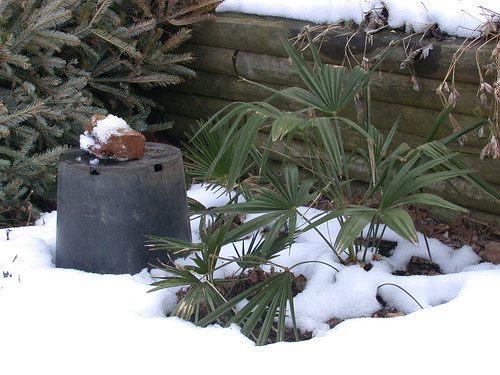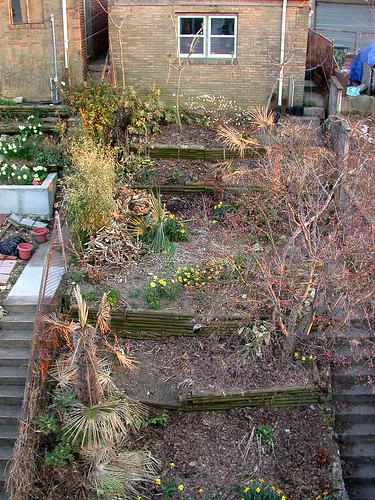 Trachycarpus wagnerianus
Trachycarpus wagnerianus at 8 degrees (F) in January 2009
Cold weather is sweeping south from Canada
later this week, with temperatures in Washington, DC possibly dropping into the low teens (F) by Saturday, and maybe even into the single digits next week. Personally, I don't trust any weather forecast that's more than 3 or 4
days away. But let's face it, this is winter, and winter gets cold!
We've been very lucky the past few years, with warmer-than-average
winters, and sooner or later winter has to catch up to us.
These would be the coldest temperatures my plants have experienced since January 2009, when I recorded 8 degrees (F) in my back yard. After that cold spell, several of my hardy palms suffered serious damage. The first sign of trouble was the freeze-dried appearance of the fronds of
Trachycarpus wagnerianus (as seen in the photo above). These fronds ended up dying and the plants were nearly defoliated. None of them died outright, putting out new growth the following summer, and fortunately we had a series of warmer winters after that, with nothing lower then the mid-teens. Even so, two of my "waggies" were so weakened that they succumbed to the following winter, even though it was considerably warmer. The one survivor has put out very strong growth since then, possibly because they were planted too close together and its competition was eliminated! Here is how it looked in October 2012, next to
Trachycarpus fortunei "Nainital" (which has proven much hardier for me and sailed through the 2008-2009 winter with minimal damage):
 Trachycarpus wagnerianus
Trachycarpus wagnerianus (left),
T. fortunei "Nainital" (right)
I always have mixed feelings about these winter forecasts. On the
one hand, I don't want to lose any plants, especially not palms that
I've grown from seed or otherwise invested with a decade of
cultivation. On the other hand, I want to find out how hardy they
really are, and protecting them won't tell me that. I made a conscious decision several years ago that I was willing to risk losing the plants and I haven't protected any palms since February 2005, and then only my
Trachycarpus wagnerianus as they were still very small seedlings. None of my other palms have ever received any protection other than a generous layer of mulch. Frankly, I find it too much work to protect plants and you can see how much effort I put into it for my "waggies":

Sophisticated palm protection, February 2005
Incidentally, this is what my
fatsias looked like after the same cold event--believe it or not, they completely recovered from their infamous "fatsia flop" with no damage whatsoever:
 Fatsia japonica
Fatsia japonica at 8 degrees (F) in January 2009












